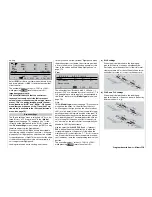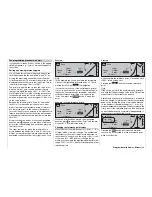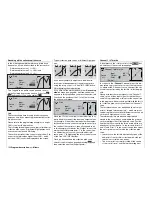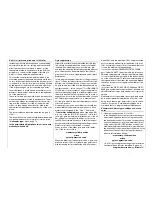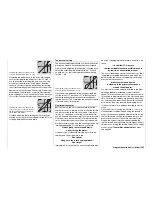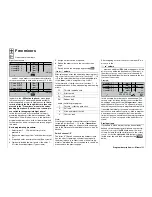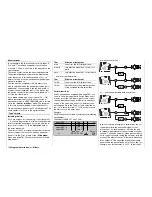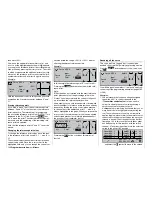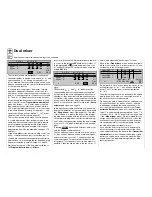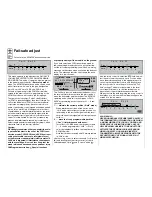
133
Program description:
Mixers
ective pitch / throttle” line of the »
Stick mode
« menu
(see page 77). In this case the C1 trim is only active
in the auto-rotation fl ight phase. However, its setting
can also be altered outside this phase.
This pre-set facility is specially designed to provide a
simple means of moving on from practice auto-rota-
tion landings with the motor running to a fi nal auto-
rotation landing with the motor stopped. For this re-
ason the C1 trim lever can be brought to a position at
which the motor will stop at a suitable moment before
the pilot switches to the “Autorot” fl ight phase.
Tail rotor offset AR
For normal fl ying the tail rotor is set up in such a way
that it compensates for motor torque when the heli-
copter is hovering. This means that it already genera-
tes a certain amount of thrust even in its neutral posi-
tion. The level of thrust is then varied by the tail rotor
control system, and also by the various mixers which
provide all manner of torque compensation, while the
tail rotor trim is also used to compensate for varying
weather conditions, fl uctuations in system rotational
speed and other infl uences.
However, in an auto-rotation descent the main rotor
is not driven by the motor, and therefore there is no
torque effect for which compensation is required, i. e.
which the tail rotor would have to correct. For this re-
ason all the appropriate mixers are automatically swit-
ched off in auto-rotation mode. However, the basic
tail rotor setting must also be different for auto-rotati-
on, as the corrective thrust described above is no lon-
ger required.
Cut the motor and place the helicopter on the ground
in a level attitude. With the transmitter and receiving
system switched on, fold both tail rotor blades down
and change the blade pitch angle to zero degrees by
adjusting the value of the “Tail rotor offset” line. View-
ed from the tail, the tail rotor blades should now lie
parallel to each other. Depending on the friction and
running resistance of the gearbox it may be that the
fuselage still yaws slightly in an auto-rotation descent.
The relatively slight torque which causes this effect
must then be corrected if necessary by adjusting the
tail rotor blade pitch angle. This value will always be a
small fi gure between zero degrees and a pitch angle
opposed to the direction of tail rotor pitch required for
normal fl ight.
The adjustment range is -125% to +125%.
(Pressing
CLEAR
= 0%.)
Final note:
As you would expect, the
mx
-24s offers the facility to
trim the roll and pitch-axis functions (and especially
the tail rotor setting) using the digital trims, which can
be set separately in all fl ight phases. This is availab-
le in the auto-rotation phase as in the other fl ight pha-
ses. See the »
Stick mode
« menu on page 77.
Summary of Contents for mx-24s
Page 1: ...1...
Page 19: ...19 For your notes...
Page 35: ...35 For your notes...
Page 41: ...41 41 For your notes...
Page 57: ...57 For your notes...
Page 63: ...63 63 For your notes...
Page 69: ...69 69 For your notes...
Page 85: ...85 85 For your notes...
Page 99: ...99 For your notes...
Page 143: ...143 For your notes...
Page 191: ...191 For your notes...
Page 212: ...212 212 For your notes...
Page 213: ...213 213 For your notes...
Page 214: ...214 For your notes...
Page 216: ...216...

